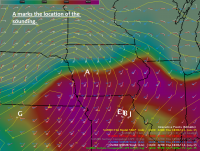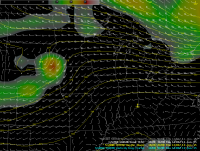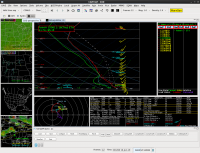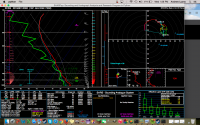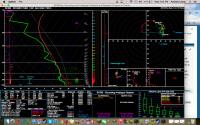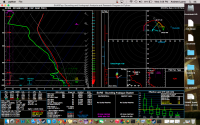adlyons
EF2
Looking at the possibility of a few severe storms near the surface low moving into Iowa. Looks to be a significant chance of wind and hail and a more isolated tornado threat if cells can manage to tap some of the stronger turning near the warm front. Taking a look at current obs, the gulf is open quiet nicely. 70's dewpoints reside across the south and upper 70's along the coast. High pressure is parked over the southeast which will promote return flow over the next 36 hours. Dews in the target area in central and western Iowa are currently in the low 60's. A cold front is slowly sliding south from Minnesota and will park over the next 12-24 hours. Exact positioning is up for debate but it looks to stall through central/ southern Iowa. Looking up, H5 flow is northwesterly with a ridge to the west. The ridge begins to weaken slightly as the axis shift eastward in response to a closed low coming into coastal California. Diving into model land with the 80 km NAM we see a shortwave trough develop and move into the area early thursday. At the surface a lee cyclone develops on wednesday and attaches to the stalled front over the central plains. It begins translating northeastward along with the shortwave aloft. The low appears to be fairly strong near 1000 mb. This backs the surface winds fairly strongly near the front. ECMWF agrees with the relative strength and location of the low as well as the backed nature of low level flow. With strong moisture good heating and okay shear, severe params jump up. One possible complicating factor is the presence of a decaying MCS from the night before. Hi res guidance has continually placed this in and around the area between 15-18z. However, cloud breaks to the west do show up on several runs. 0-6km shear is also angled to surface boundaries which could mean a messy storm mode with short line segments and semi discrete cells. Soundings from the immediate vicinity of the front show strong instability as well as good turning in the 0-2km layer and moderately strong low level wind fields. 0-6 km shear is 45-50 knots along the front and 35-40 30 miles south. This is adequate One thing to note was that the 10-200 m winds are almost perpendicular to the progged storm motion. This equates to nearly 100% streamwise vorticity ingestion in the lowest level storm relative inflow and is often associated with tornadoes. Sig tor parameter is upwards of 2 which leads me to believe at least an iso tornado threat does exists. I expect a fairly quick transition to an eastward moving MCS with a wind and hail threat. Iso qlcs tors would still be possible. Something to watch over the next few runs.

